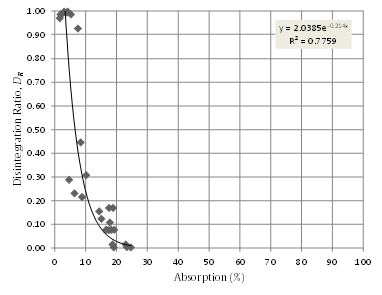The Use of Disintegration Ratio in Evaluating Rock Durability in Selected Mudrock Samples in Indonesia
DOI:
https://doi.org/10.25299/jgeet.2019.4.3.2331Keywords:
Disintegration Ratio, Durability, Mudrocks, Disintegration Index TestAbstract
Characterization of durability of mudrocks is important regarding its slaking behaviour within a short time when exposed to and or interact with water. Some relevant cases that occurred due to slaking are damage to roads and slope failures along the Cipularang and Cipali Toll Road. Current engineering activities related to the presence of mudrocks are being and will be held in several locations in Indonesia such as the construction of the Cisumdawu Toll Road in Ujungjaya District, Sumedang and building the National Observatory in Timau District, Kupang. This research is useful for providing engineering considerations related to those activities.
The methods used in this research included X-ray diffraction to obtain mineralogy of mudrock, laboratory testing of physical properties of rocks such as dry density, water content, porosity, absorption and mudrocks durability tests. Durability of rocks was determined by disintegration index test. Testing was carried out by wetting and drying of rock samples.
Test results showed that the average disintegration ratio of claystones, shales, mudstones and siltstones are 0.1035, 0.2183, 0.4942 and 0.9900. Slaking mode occurs to claystones, mudstones and shales is body slaking while dispersion slaking occurs to siltstones. Evaluation of the durability of mudrocks in this research indicates that siltstones have the highest durability characterized by very slow disintegration, followed by mudstones, shales and claystones at the lowest with very quick disintegration. Disintegration ratio from the disintegration index test characterizes the durability of mudrocks in more details. It can be concluded that porosity and absorption are incorporated into the main factors affecting the durability of mudrocks.
Downloads
References
Clayton, C.R.I., Matthews, M.C., Simons, N.E., 1987. Site investigation. Department of Civil Engineering, University of Surrey.
Czajka, R., 1994. Determination of variability of physical properties in a selected layer (from the Baltic cliff) using statistical methods. Bull. Int. Assoc. Eng. Geologists 49, 33–39. doi: 10.1007/BF02594998
Czerewko, M.A. Cripps, J.C., 2001. Assessing the durability of mudrocks using modified jar slake index test. Quarterly Journal of Engineering Geology and Hydrogeology 34, 153–163. doi: 10.1144/qjegh.34.2.153
Davis, J.C., 1973. Statistics and data analysis in geology. John Willey & Sons, New York.
Dick, J.C., Shakoor, A., 1992. Lithologic controls of mudrock durability. Quarterly Journal of Engineering Geology 25, 31–46. doi: 10.1144/GSL
Dick, J.C., Shakoor, A., Wells, N., 1994. A geological approach toward developing a mudrock-durability classification system. Can. Geotech. J. 31, 17–27. doi:10.1139/t94-003
Djuri, 1973. Geological Map of Arjawinangun, Java Quadrangle, Scale 1:100.000. Center of Research and Development of Geology, Bandung.
Erguler, Z.A., Shakoor, A., 2009. Relative contribution of various climatic processes in disintegration of clay-bearing rocks. Eng. Geol. 108, 36–42. doi:10.1016/j.enggeo.2009.06.002
Erguler, Z.A., Ulusay, R., 2009. Assessment of physical disintegration characteristics of clay-bearing rocks: Disintegration index test and a new durability classification chart. Eng. Geol. 105, 11–19. doi:10.1016/j.enggeo.2008.12.013
Franklin, J.A., Chandra, R., 1972. The slake-durability test. Int. J. Rock Mech. Min. Sci. 9, 325–328. doi:10.1016/0148-9062(72)90001-0
Gautam, T.P., 2013. An investigation of distribution behavior of mudrocks based on laboratory and field tests. Kent University, USA (dissertation).
Gautam, T.P., Shakoor, A., 2013. Slaking behavior of clay-bearing rocks during a one-year exposure to natural climatic conditions. Eng. Geol. 166, 17–25. doi:10.1016/j.enggeo.2013.08.003
Gokceoglu, C., Aksoy, H., 2000. New approaches to the characterization of clay-bearing, densely jointed and weak rock masses. Eng. Geol. 58, 1–23. doi:10.1016/S0013-7952(00)00032-6
ICDD, 2002. The power diffraction file PDF2 database. International Centre for Diffraction Data, USA.
ISRM, 1981. ISRM Suggested methods: rock characterization, testing and monitoring. Brown, E.T. (Ed.), London.
ISRM, 2007. The complete isrm suggested methods for rock characterization, testing and monitoring: 1974–2006 in Ulusay, R., Hudson, J.A. (Eds.). Suggested methods prepared by the commission on testing methods, International Society for Rock Mechanics (ISRM), Ankara, Turkey.
Koncagu, E.C., Santi, P.M., 1999. Predicting the unconfined compressive strength of the Breathitt shale using slake durability, shore hardness and rock structural properties. International Journal of Rock Mechanics and Mining Sciences 36, 139–153. doi: 10.1016/s0148-9062(98)00174-0
Martodjojo, S., 2003. Evolusi Cekungan Bogor, Jawa Barat, ITB Press, 238.
Misbahudin, M., 2017. Characterization of the Durability of Mudrocks using Disintegration Index Test. Institut Teknologi Bandung (thesis)
Misbahudin, M., Sadisun, I.A., 2018. Durability Analysis of Subang Formation Claystones in Ujungjaya Area and Surroundings, Sumedang Regency, West Java. Bull. Geol. 2, 163–174. doi:10.5614/bull.geol.2018.2.1.3
Olivier, H.J., 1979. A new engineering-geological rock durability classification. Engineering Geology 14, 255–279. doi: 10.1016/0013-7952(79)90067-X
Rosidi, H.M.D., Tjokrosapoetro, S., Gafoer, S., 1996. Geological Map of Kupang-Atambua, Timor Quadrangle, Scale 1:250.000. Center of Research and Development of Geology, Bandung.
Sadisun, I.A., Shimada, H., Ichinose, M., Matsui, K., 2005. Study on the physical disintegration characteristics of Subang claystone subjected to a modified slaking index test. Geotech. Geol. Eng. 23, 199–218. doi:10.1007/s10706-003-6112-6
Sukamto, R.A.B., 1975. Geological Map of Jampang and Balekambang, Java Quadrangle, Scale 1:100.000. Center of Research and Development of Geology, Bandung.

Downloads
Published
Issue
Section
License
Copyright @2019. This is an open-access article distributed under the terms of the Creative Commons Attribution-ShareAlike 4.0 International License which permits unrestricted use, distribution, and reproduction in any medium. Copyrights of all materials published in JGEET are freely available without charge to users or / institution. Users are allowed to read, download, copy, distribute, search, or link to full-text articles in this journal without asking by giving appropriate credit, provide a link to the license, and indicate if changes were made. All of the remix, transform, or build upon the material must distribute the contributions under the same license as the original.










